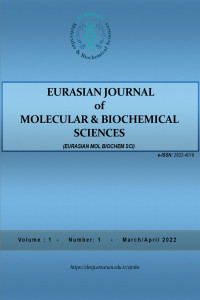Investigation of the effects of different genotypes on regeneration capacity in Triticale
Investigation of the effects of different genotypes on regeneration capacity in Triticale
Triticale (x Triticosecale Wittmack) is a synthetic amphiploid cereal that grows on about 3 million hectares in the world. It is grown mostly for forage or animal feed, although some triticale-based foods can be purchased at health food stores or are found in some breakfast cereals. Mature embryos of two triticale cultivars (Ümran Hanım and Melez 2001) were used as the resources explants. The effects of one auxin type (2,4-D) and three various concentrations, (4.0 mg/l; 8mg/l; 12.0mg/l) callus formation and plant regeneration were determined. Callus formation values were detected over 85% in three concentrations. In terms of results, the highest embryogenic callus formation rate was determined 46.91 % at 12 mg/l of Ümran Hanım dicamba. However, the lowest embryogenic callus formation rate was found with a value of 12.86% in Ümran Hanım's 2,4-D 8.0 mg/l hormone application. The highest regeneration capacity was determined at 12.09% at a dose of 12.0 mg/l of Mikham 2001 2,4-D. However, the lowest regeneration capacity was determined at 2.2% at the dose of 4 mg/l of Ümran Hanım 2,4-D. Our results displayed that auxin type and hormone dosage were very significant on the triticale mature embryos.
Keywords:
In vitro culture, Plant regeneration, Callus, Hormones.,
- Başlangıç: 2022
- Yayıncı: Erzurum Teknik Üniversitesi
Sayıdaki Diğer Makaleler
The potential role of long non-coding RNAs and micro RNAs in insects: From junk to luxury
Insha SHAFİ, Mudasir GANİ, Sadiah SHAFİ, Taskeena HASSAN, Mohd. Ayoub MANTOO, Kamlesh BALİ, Rakesh Kumar GUPTA
Investigation of the effects of different genotypes on regeneration capacity in Triticale
İsmail BEZİRGANOGLU, Serap KARAMAN, Beyza REİSOĞLU, Fatma BÖKE, Büşra YAZICILAR
Şimal TOPÇU, Elif ARSLAN, Şeymanur ÇOBANOĞLU, Ayşenur YAZICI, Ümit İNCEKARA
Effect of Bortezomib administration on autophagic cell death in colorectal cancer cells
Elif ERBAŞ, Nevra AYDEMİR CELEP, Kader ÇİFTÇİ
Cihan GÜR, Seçkin ÖZKANLAR, Semin GEDİKLİ, Emin ŞENGÜL, Volkan GELEN, Adem KARA
